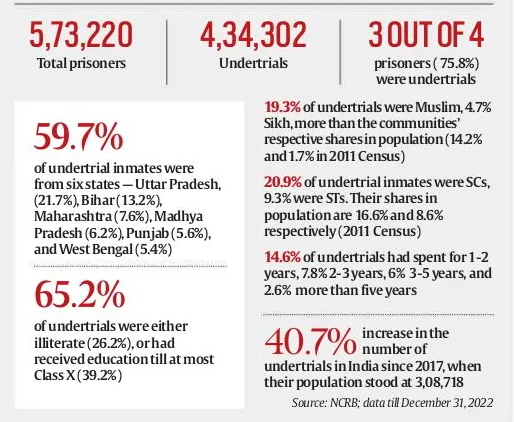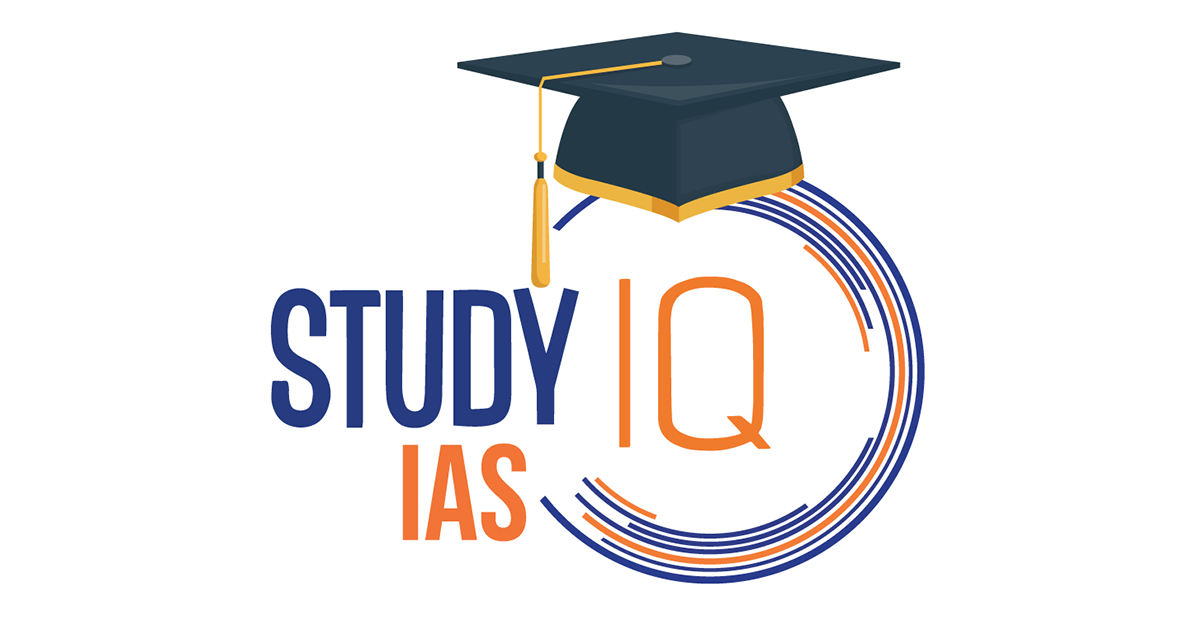Table of Contents
Union Home Minister Amit Shah urged the release of undertrial prisoners who have spent more than one-third of the maximum prescribed sentence for their crime before Constitution Day (November 26).
| Section 479 of the BNSS |
|
Introduction
- The prison system in India is currently facing a critical crisis characterised by severe overcrowding, a high percentage of undertrial prisoners, and systemic issues that undermine the rights and dignity of inmates.
- Over 75% of India’s prison population are undertrials while overcrowding in Indian prisons stands at 118%.
- This marks a significant increase from 66% in 2012, highlighting a troubling trend over the past decade.

Marginalised Communities in Jails: Data
- Prison Statistics India report 2021 revealed that the number of convicts in jails decreased by 9.5 per cent, whereas the number of undertrial inmates increased by 45.8 percent between 2016 and 2021.
- Over 3 out of 5 undertrial prisoners lodged across Indian prisons, are from Dalit, Adivasi and OBC communities, according to the latest Prison Statistics of India Report (2021).
- The latest National Crime Records Bureau (NCRB) data reveals that 94% of undertrials were from a Scheduled Caste, 9.26% belonged to a Scheduled Tribe, and 35.88% were from a socially and educationally backward community.
Problems with India’s Bail System
- Lack of empirical data: No data exists to understand the factors impacting undertrial incarceration (bail application rates, acceptance/rejection rates, reasons for denial, etc.).
- Inadequate Safeguards Against Arbitrary Arrest: Effective safeguards against arbitrary arrest are lacking, particularly affecting disadvantaged groups at a higher risk due to socio-economic conditions.
- Example: Data from the Fair Trial Programme in Yerwada and Nagpur prisons indicate that migrants, asset-less individuals, and those without family contact or with a history of incarceration are disproportionately affected.
- Bail Adjudication Practices: Courts’ discretionary power in bail grants often leads to stringent conditions or denial, especially for marginalised individuals, without transparent rationale.
- Example: Conditions like cash bonds and proof of property ownership further alienate undertrials from marginalised backgrounds, contradicting the intent to ensure ‘bail not jail’.
- Challenges in Bail Compliance: Many undertrials remain incarcerated post bail grant due to the inability to meet onerous bail conditions, highlighting systemic issues in compliance facilitation.
- Example: Factors such as lack of financial means, absence of local sureties, and navigational challenges in the legal system exacerbate the situation, requiring supportive interventions for vulnerable groups.
- Misguided Presumptions of the Bail System: The current bail system operates on flawed assumptions about the financial capabilities and social connections of arrested persons, undermining the principle of ‘bail not jail’.
Reasons Behind High Number of Marginalised Communities in Prison
- Deeply Entrenched Prejudices: Societal biases against marginalised communities, such as Dalits and Adivasis, often manifest in the criminal justice system.
- These prejudices can influence police behaviour, judicial proceedings, and public perception, leading to discriminatory practices.
- Example: A study found that Dalits are disproportionately represented in custodial deaths and wrongful arrests due to systemic bias.
- Lack of Awareness: Many prisoners belonging to marginalised communities are unaware of their fundamental rights, the preamble, and their fundamental duties, contributing to their overrepresentation in jails.
- High Litigation Costs: Excessive costs involved in litigation act as a major barrier to accessing justice, leading to prolonged incarcerations.
- Cycle of Criminalisation: Once individuals from marginalised communities enter the criminal justice system, they may be repeatedly targeted and profiled for offences, perpetuating a cycle of criminalization and marginalisation.
- Criminalisation of Customary Practices: Customary practices of Adivasi communities are often criminalised without understanding their cultural context.
- Example: Tribal youths in Tamil Nadu’s Nilgiris district are routinely arrested under the Protection of Children from Sexual Offences (POCSO) Act for consensual relationships, a common practice among their community.
- Empathetic Handling Lacking: The prosecution system is often under-resourced and lacks adequate training, which leads to ineffective handling of cases (without sensitivity) involving marginalised communities.
Challenges faced by marginalised communities in Prison
- Custodial Abuse: Inmates from marginalized backgrounds often experience physical and sexual abuse within prisons. The lack of oversight and accountability allows such abuses to persist unchecked.
- Disconnection from Families: Family visits can be financially burdensome for marginalised inmates, leading to isolation and a breakdown of familial ties during incarceration.
- This disconnection further complicates their reintegration into society post-release.
- Inhumane Treatment: Conditions in prisons such as inadequate sanitation, food shortages, and rampant disease outbreak disproportionately affect marginalised communities who already face systemic disadvantages
- Lack of Access: Many undertrial prisoners from marginalised backgrounds face significant barriers in obtaining legal aid.
- Although nearly 80% of the population qualifies for legal aid, only a small fraction has received assistance since the establishment of legal services institutions in 1987.
- Additionally, the quality of free legal services is often inadequate, leaving many individuals vulnerable to prolonged incarceration without proper representation.
Challenges for Prisoners with Disabilities
- Prisoners with disabilities are targets for abuse and violence and often face neglect in meeting their special needs.
- Example: Father Stan Swamy, who had Parkinson’s disease, was denied basic assistive tools like a straw and sipper, making it difficult for him to eat or drink.
- Accessibility Gaps:: A 2018 audit of Delhi prisons (Tihar, Rohini, and Mandoli) by the Nipman Foundation identified:
- Lack of functional wheelchairs.
- Inaccessible prison cells, toilets, mulaqat rooms, and recreational spaces.
- Water coolers located in areas without accessible entries.
Rights of Prisoners and International Obligations
- Constitutional and Legal Protections
- Prisoners are entitled to equality, freedom, and life with dignity, as upheld in Upendra Baxi vs State of U.P. (1983).
- The Rights of Persons with Disabilities Act (2016) requires the state to protect persons with disabilities from abuse, violence, exploitation, and denial of basic needs.
- Example: Denying a straw and sipper to Father Stan Swamy violated this law.
- International Obligations
- Nelson Mandela Rules (2015): Require reasonable accommodations for prisoners with disabilities.
- UN Convention on the Rights of Persons with Disabilities: Prohibits torture and degrading treatment.
- Policy Guidelines
- Model Prison Manual (2016): Mandates dignified living conditions for prisoners.
- Accessibility Guidelines (2024): Issued by the Ministry of Home Affairs to make prison facilities accessible.
Supreme Court Interventions
- Upendra Baxi vs State of U.P. (1983): The Supreme Court upheld that prisoners are entitled to equality, freedom, and life with dignity.
- Rama Murthy vs State of Karnataka (1996): The Supreme Court directed the government to address issues like overcrowding, trial delays, torture, and neglect.
- Arnesh Kumar vs State of Bihar: The Supreme Court had stated that the police should ordinarily not arrest people if the offence they are charged with has a maximum sentence of less than or up to seven years.
- In all such offences, police should ordinarily not arrest, they should send a notice and only if the person doesn’t cooperate with investigation, only then they can arrest if they want.
- Hussainara Khatoon v. Home Secretary, State of Bihar (1979) case: The Supreme Court ruled that keeping undertrial prisoners incarcerated for longer than their potential punishment constitutes a clear violation of their fundamental rights ( Article 21).
Way Forward
- Idea of open prisons must be considered seriously.
- Need to strengthen Lok Adalats for minor offences such as traffic infringements, excise offences, shoplifting, and disorderly public conduct.
- There should be an alternative bail system. It should not be only financial.
- Better training for police, more courts, more court halls, more court staff.
- Speedy trial can become the effective tool
- g. Special fast track courts to be set up to extensively deal with petty offences and for cases pending for five years or more
- Regularly monitor the progress of cases pending in courts.
- Application of AI in criminal case management.
- E-prisons developed by National Informatics Centre to integrate all activities related to prison and prisoner management.


 Teesta River Dispute between India and B...
Teesta River Dispute between India and B...
 Earthquake in Myanmar, Causes, Impact an...
Earthquake in Myanmar, Causes, Impact an...
 India’s Deep Sea Technology, Need and ...
India’s Deep Sea Technology, Need and ...





















